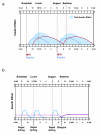A practical approach for implementation of a basal-prandial insulin therapy regimen in patients with type 2 diabetes
- PMID: 17448241
- PMCID: PMC1885266
- DOI: 10.1186/1750-4732-1-9
A practical approach for implementation of a basal-prandial insulin therapy regimen in patients with type 2 diabetes
Abstract
Basal-prandial insulin therapy is a physiologic approach to insulin delivery that utilizes multiple daily injections to cover both basal (ie, overnight fasting and between-meal) and prandial (ie, glucose excursions above basal at mealtime) insulin needs. While basal-prandial therapy with multiple daily injections is an important therapeutic option for patients with type 2 diabetes, there is a common perception that this therapy is difficult to initiate in the primary care setting. To address this issue, a panel of clinical experts convened to develop practical recommendations on how to initiate basal-prandial therapy in patients with type 2 diabetes, focusing on patient selection, simple dosing and titration, and monitoring. Patients with type 2 diabetes who are appropriate candidates for basal-prandial insulin therapy include those who: 1) are unable to achieve glycemic control on oral antidiabetic drugs, 2) are unable to achieve glycemic control on split-mixed/premixed insulin regimens, 3) are newly diagnosed but unlikely to respond to oral antidiabetic drugs alone (ie, the patient has severe hyperglycemia or a markedly elevated glycosylated hemoglobin A1C level for which oral antidiabetic drug therapy alone is unlikely to achieve goals), and 4) prefer this therapy due to socioeconomic or other individual considerations. Basal-prandial insulin can be initiated in a simple stepwise manner, starting first with the addition of basal insulin to the existing oral antidiabetic drug regimen, followed by the introduction of 1 prandial insulin injection to the basal insulin plus oral antidiabetic drug regimen (after basal insulin has been optimized). Subsequently, other injections of prandial insulin may be added when needed. Based on home glucose monitoring data, patients may be converted from split-mixed or premixed insulin regimens to basal-prandial regimens with similar ease. Basal-prandial therapy using newer insulin formulations, such as long- and rapid-acting insulin analogs, can be relatively simple to use in patients with type 2 diabetes and is an appropriate methodology for application by primary care clinicians.
Figures



References
-
- Centers for Disease Control and Prevention National diabetes fact sheet: United States, 2005: general information. 2005. http://www.cdc.gov/diabetes/pubs/pdf/ndfs_2005.pdf
-
- American Association of Clinical Endocrinologists The American Association of Clinical Endocrinologists medical guidelines for the management of diabetes mellitus: the AACE system of intensive diabetes self-management-2002 update. Endocr Pract. 2002;8:40–82. - PubMed
-
- Stratton IM, Adler AI, Neil HA, Matthews DR, Manley SE, Cull CA, Hadden D, Turner RC, Holman RR. Association of glycaemia with macrovascular and microvascular complications of type 2 diabetes (UKPDS 35): prospective observational study. BMJ. 2000;321:405–412. doi: 10.1136/bmj.321.7258.405. - DOI - PMC - PubMed
LinkOut - more resources
Full Text Sources
Other Literature Sources

